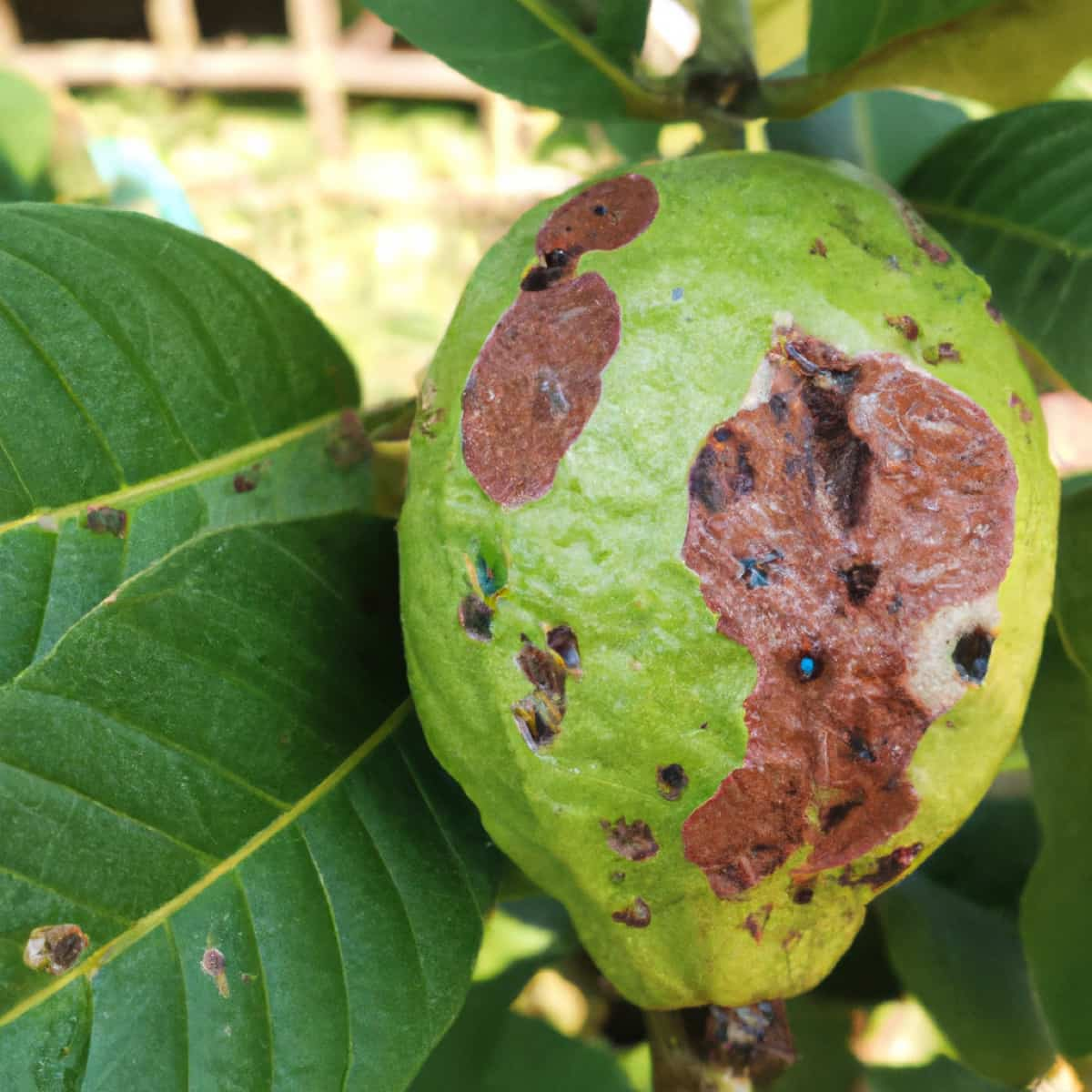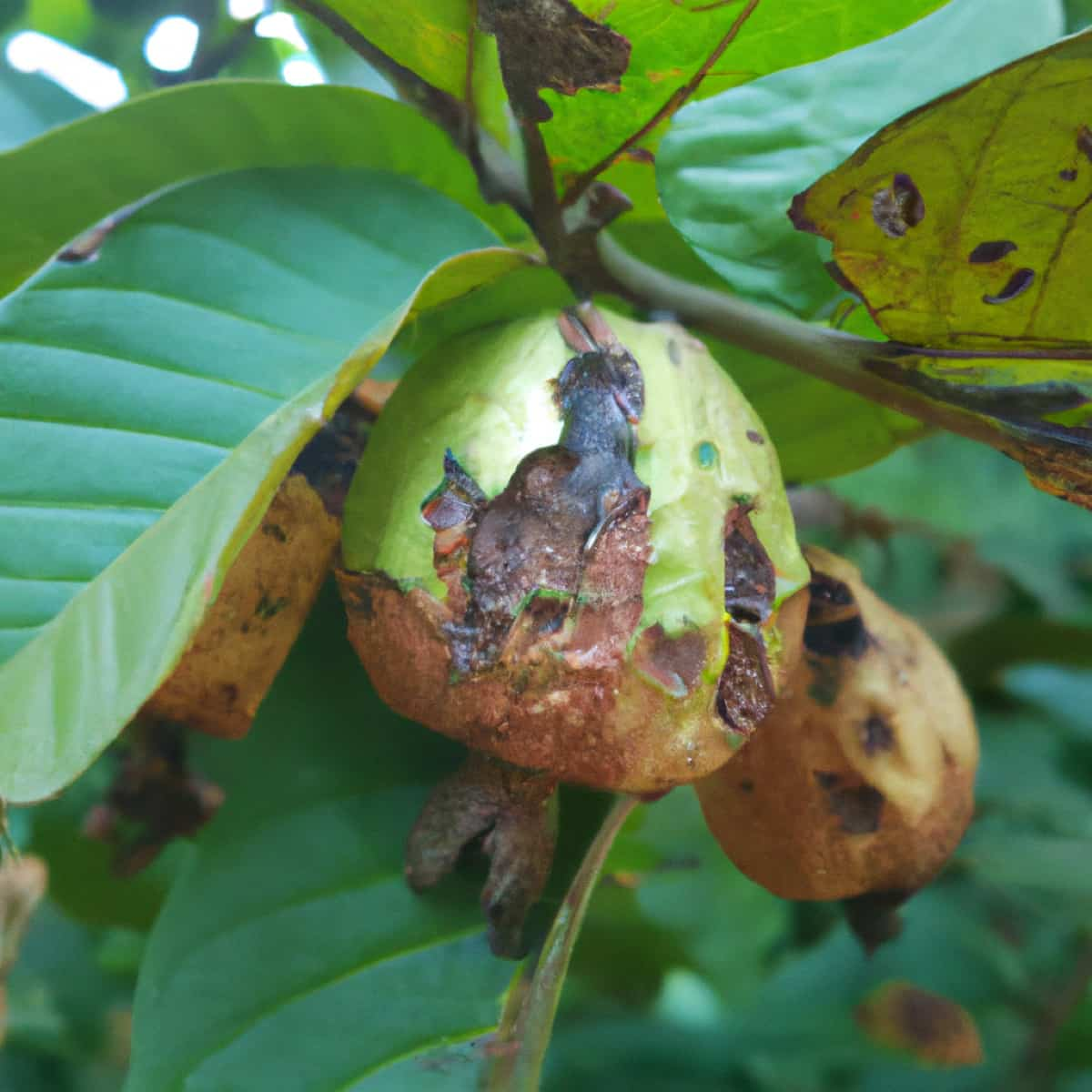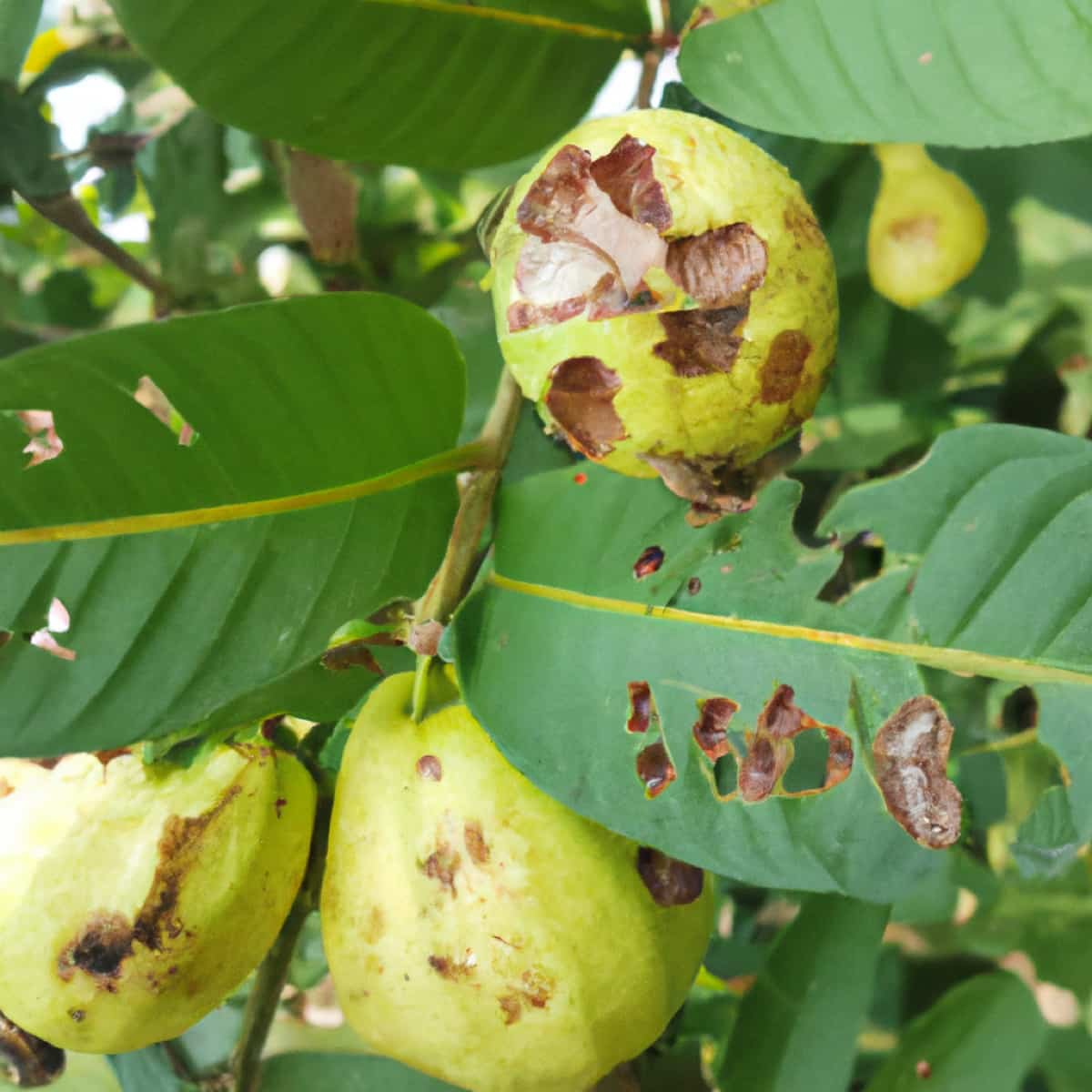Fruit Canker Disease is a common and destructive fungal disease that affects guava plants. The disease is caused by the fungus Pestalotiopsis psidii, which primarily infects the fruits, stems, and leaves of the guava plant.

Fruit Canker Disease Management in Guava:
The Causal Organism of Fruit Canker Disease
The causal organism of Fruit Canker Disease in guava is a fungus known as Pestalotiopsis psidii. This fungus belongs to the family Amphisphaeriaceae and is characterized by its ability to colonize and infect guava fruits, stems, and leaves. The fungus produces small, black fruiting bodies called pycnidia, which contain numerous spores that can be disseminated by wind or water. When the spores come in contact with a susceptible host plant, they germinate and penetrate the plant’s tissue through wounds or natural openings, such as stomata or lenticels.
Once inside the plant, the fungus produces a range of enzymes and toxins that cause necrosis or death of the plant cells. This results in the formation of circular, brown, or rust-colored lesions on the surface of the fruit, which can eventually lead to the fruit’s deformation, mummification, and drop. Under favorable conditions, such as high humidity and temperatures ranging from 15-30°C, the fungus can sporulate and produce new spores, which can be disseminated to healthy plants and start a new infection cycle.
The Disease Cycle of Fruit Canker Disease
- Inoculation: The pathogen enters the host plant through wounds or natural openings, such as stomata or lenticels, on the surface of the fruit.
- Infection: Once inside the plant, the pathogen colonizes the tissue and causes necrosis or death of the plant cells. This results in circular, brown, or rust-colored lesions on the fruit surface.
- Sporulation: As the lesions progress, they may tear open the epidermis of the fruit in a circular manner, forming a crater-like appearance. In advanced stages, white mycelium consisting of numerous spores may be visible.
- Dissemination: The spores produced by the pathogen can be disseminated by wind, rain, or contact with infected plant material, thereby spreading the disease to other healthy plants.
- Secondary infection: In conducive environmental conditions, such as high humidity and temperatures ranging from 15-30°C, the spores can germinate and infect other healthy plants, starting a new disease cycle.
Causes/Conditions Favorable for Fruit Canker Disease Spread in the Field.
- Temperature: The optimal temperature for spore germination and disease development is around 30°C. Temperatures below 15°C or above 40°C are unsuitable for spore germination or disease development.
- High humidity: The disease spreads rapidly under high humidity conditions, with relative humidity above 96%.
- Rainfall: Rainfall provides moisture for the fungus to grow and spread, leading to an increased incidence of Fruit Canker Disease.
Symptoms of Fruit Canker Disease
- Minute, brown, or rust-colored circular necrotic areas on green fruits
- The lesions tear open the epidermis of the fruit in a circinate manner.
- The margin of the lesion is elevated, and a depressed area is noticeable inside.
- The appearance of the lesion is more noticeable on fruits than on leaves, giving the fruit a crater-like appearance.
- In older cankers, white mycelium consisting of numerous spores is noticeable.
- In severe cases, raised cankerous spots to develop greatly, and the fruits break open to expose seeds.
- Infected fruits remain underdeveloped, become hard, malformed, mummified, and drop.
- Sometimes, small rusty brown angular spots appear on the leaves.
In case you missed it: Fusarium Wilt Disease Management in Guava: Symptoms, Treatment, Cultural, Chemical, Biological, and Prevention

Fruit Canker Disease Management in Guava by Cultural method
- Summer irrigation: Proper irrigation during the summer can help reduce the incidence of Fruit Canker Disease by maintaining adequate moisture levels and preventing plant stress.
- Pruning and thinning: Regular pruning and thinning of guava trees can promote good air circulation and light penetration, reducing the incidence of Fruit Canker Disease.
- Plant spacing: Proper spacing between guava trees is essential to promote good air circulation and light penetration, which can reduce the incidence of Fruit Canker Disease.
Fruit Canker Disease Management in Guava by Chemical method
- Bordeaux mixture: A 1% mixture can be applied to guava trees through three to four sprayings spaced two weeks apart. This can help prevent and control the spread of Fruit Canker Disease.
- Lime-sulfur: A 1 in 25 dilutions of lime-sulfur can be sprayed on guava trees to control Fruit Canker Disease.
- Aureofungin: A PH wash with aureofungin at a concentration of 200 ppm can protect fruits from Fruit Canker Disease for up to 5 days.
- Aretan: Dip treatment of guava fruits with Aretan can help control fruit rot caused by Fruit Canker Disease.
Fruit Canker Disease Management in Guava by Organic/Natural method
- Use of biocontrol agents: The use of biocontrol agents such as Trichoderma viride and Pseudomonas fluorescens are effective against the pathogen Pestalotiopsis psidii. These agents can be applied to the soil or sprayed on the plants.
- Use of organic fertilizers: Using organic fertilizers such as compost and vermicompost can help improve soil health and plant immunity. This can make the plants more resistant to diseases.
Preventive Measures for Control of Fruit Canker Disease
- Use canker disease-free nursery plants: It is essential to use healthy nursery plants free from the pathogen to avoid introducing the disease into the orchard.
- Pruning and burning infected twigs: Infected twigs should be pruned and burned to prevent the spread of the disease to healthy parts of the plant. The pruning should be done during the dormant season, and care should be taken to avoid injuring the plant.
- Spraying copper-based bactericides: Copper-based bactericides can control the disease by reducing the number of spores on the surface of the fruit and leaves. The bactericides should be applied before the onset of the disease and at regular intervals to maintain their effectiveness.
- Developing canker-resistant varieties: Guava varieties resistant to the pathogen can be an effective long-term strategy for controlling the disease. This can be achieved through breeding or genetic modification of the plant.
In case you missed it: Fruit Rot Disease Management in Guava: Symptoms, Treatment, Cultural, and Chemical Control

Conclusion
Effective control of Fruit Canker Disease in guava involves understanding the life cycle of the causal organism and implementing strategies to interrupt its spread. This can include good orchard management practices, such as sanitation, pruning, proper irrigation and nutrition, and cultural and chemical control methods.
- Types of Fungicides Used in Agriculture
- Common Issues in the Fruit Development Stage of Pomegranate Farming
- Fruit Development Issues in Papaya: Easy Solutions and Treatment
- Soil-Borne Diseases and How to Protect Your Plants
- Practices to Prevent Disease Spread in the Garden
- From Wilted to Thriving: How to Treat Root Rot Naturally in Houseplants
- Natural Remedies to Cure Brown Spots on Fig Tree Leaves
- Natural Solutions for Poinsettia Problems: 100% Effective Remedies
- How to Control Calla Lily Problems: Natural Remedies for Leaf and Flower Problems
- How to Fix Morning Glory Problems: Natural Remedies for Leaf and Flower Issues
- Natural Remedies for Tulsi Plant Problems: 100% Effective Solutions for Home Gardeners
- Natural Pesticides for Zinnias: 100% Effective to Kill Bugs on Zinnia Plants
- How to Fix Daisy Leaf and Flower Problems: Exploring Causes and Natural and Home Remedies
- Natural Ways to Fix Common Agave Plant Problems: Exploring Causes and Solutions
- Natural Ways to Fix Common Bamboo Plant Problems: Exploring Causes and Solutions
- Natural Ways to Fix Common Spider Plant Problems: Exploring Causes and Solution
- Natural Ways to Fix Common Snake Plant Problems: Exploring Causes to Solution
- How to Get Rid of Fireworms in Gardens: 100% Effective Control Strategies
- How to Get Rid of Kudzu Bug In Garden: A Comprehensive Guide to Control and Treatment
- Reviving Yellowing Meyer Lemon Leaves: Causes and Solutions
- How to Get Rid of Twig Girdlers: 100% Effective Control Strategies
- Ultimate Guide to Managing Peacock Plant Pests and Diseases: Prevention and Treatment
- How to Get Rid of Crane Flies in Lawns: 100% Effective Control Strategies
- Identifying and Managing Sudden Death Syndrome in Soybeans
- How to Get Rid of Billbugs in Lawns: 100% Effective Control Strategies
- How to Manage Red Crown Rot in Soybean: Control and Prevention Strategies
- Soybean Yield Boost: Tackling Soybean Cyst Nematode with Expert Strategies
- Turning Over a New Leaf: Fixing Yellowing Leaves on Peach Trees
- Management of Philodendron Pests and Diseases: Effective Strategies for Control, Treatment and Prevention
- Maximizing Agricultural Yields: Effective Strategies for Ragweed Management
- Systemic Insecticides for Aphid Control: A Comprehensive Guide
- How to Get Rid of Armored Scale Insects: Remedies and Treatment
- How to Get Rid of Apple Snail Eggs in the Garden: Treatment and Remedies
- Ultimate Guide for Applying Acaricide Insecticides for Tick Control
- How to Get Rid of Bagworms: A Comprehensive Guide to Control and Treatment
- Comprehensive Guide to Canola Pest and Disease Management: Strategies and Solutions